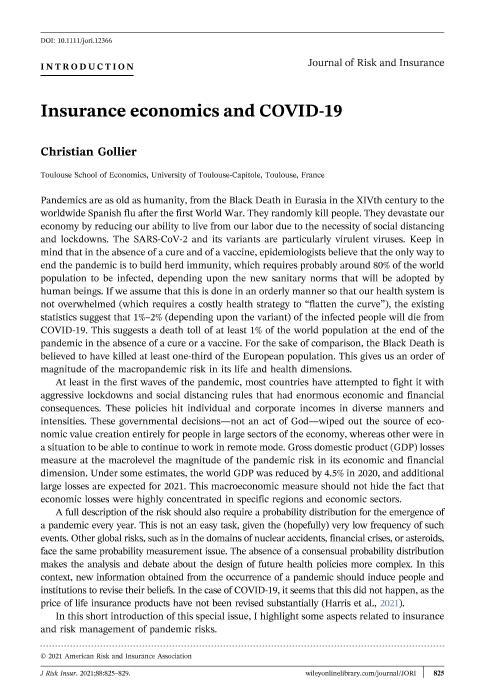Insurance economics and COVID-19

Contenido multimedia no disponible por derechos de autor o por acceso restringido. Contacte con la institución para más información.
| Tag | 1 | 2 | Valor |
|---|---|---|---|
| LDR | 00000cab a2200000 4500 | ||
| 001 | MAP20210034497 | ||
| 003 | MAP | ||
| 005 | 20211201094733.0 | ||
| 008 | 211201e20211201esp|||p |0|||b|spa d | ||
| 040 | $aMAP$bspa$dMAP | ||
| 084 | $a219 | ||
| 100 | 1 | $0MAPA20080219314$aGollier, Christian | |
| 245 | 1 | 0 | $aInsurance economics and COVID-19$cChristian Gollier |
| 520 | $aPandemics are as old as humanity, from the Black Death in Eurasia in the XIVth century to the worldwide Spanish flu after the first World War. They randomly kill people. They devastate our economy by reducing our ability to live from our labor due to the necessity of social distancing and lockdowns. The SARS-CoV-2 and its variants are particularly virulent viruses. Keep in mind that in the absence of a cure and of a vaccine, epidemiologists believe that the only way to end the pandemic is to build herd immunity, which requires probably around 80% of the world population to be infected, depending upon the new sanitary norms that will be adopted by human beings. If we assume that this is done in an orderly manner so that our health system is not overwhelmed (which requires a costly health strategy to flatten the curve), the existing statistics suggest that 1%2% (depending upon the variant) of the infected people will die from COVID-19. This suggests a death toll of at least 1% of the world population at the end of the pandemic in the absence of a cure or a vaccine. For the sake of comparison, the Black Death is believed to have killed at least one-third of the European population. This gives us an order of magnitude of the macropandemic risk in its life and health dimensions. | ||
| 650 | 4 | $0MAPA20080586294$aMercado de seguros | |
| 650 | 4 | $0MAPA20080552022$aPandemias | |
| 650 | 4 | $0MAPA20200005599$aCOVID-19 | |
| 773 | 0 | $wMAP20077000727$g01/12/2021 Volumen 88 Número 4 - diciembre 2021 , p. 825-829$x0022-4367$tThe Journal of risk and insurance$dNueva York : The American Risk and Insurance Association, 1964- |

